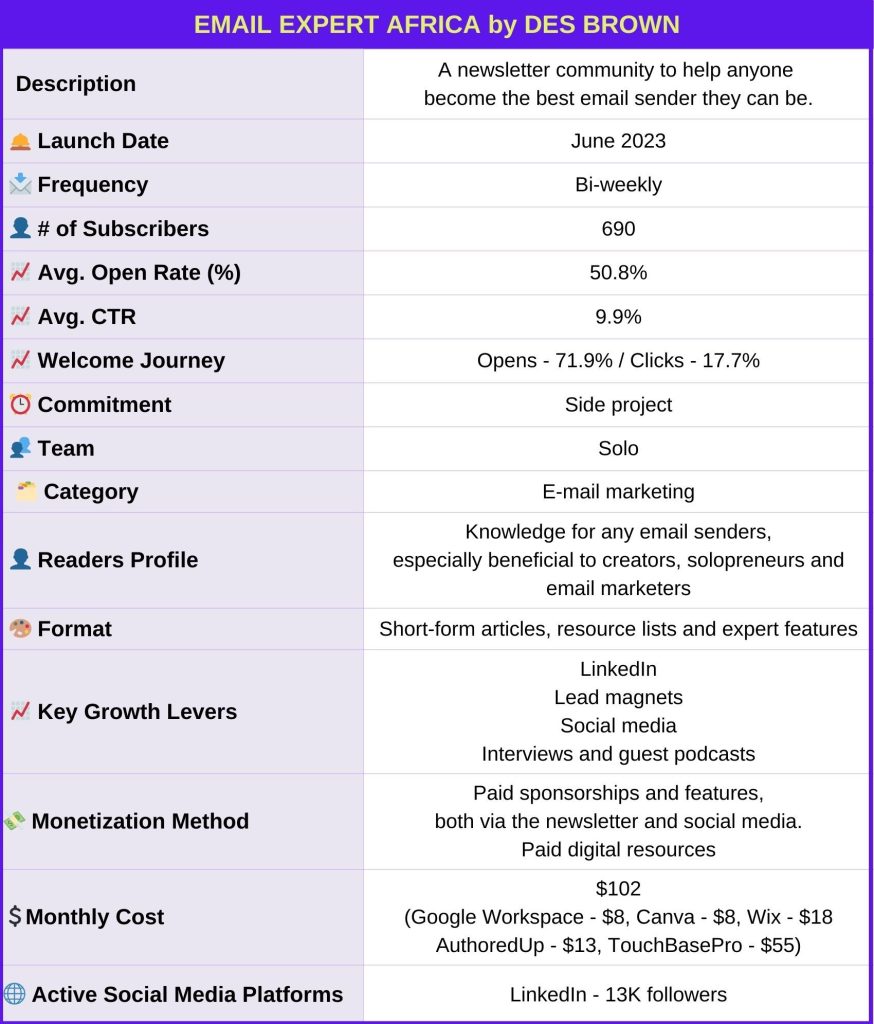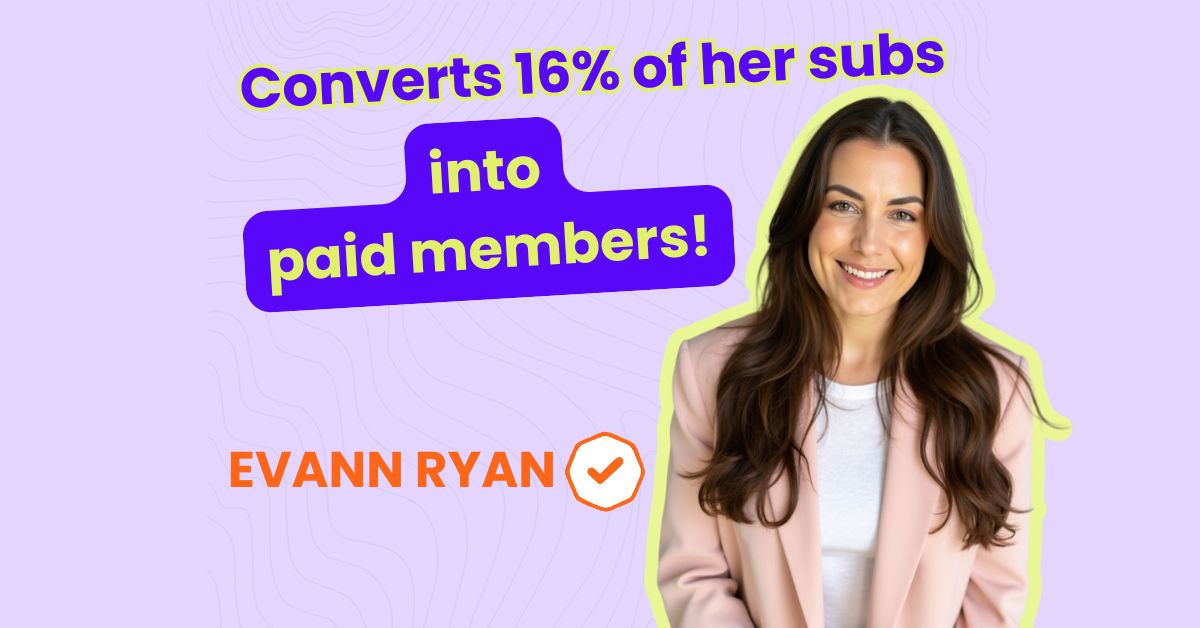Interview Date: June 02, 2024
Table of Content
CREATOR INTERVIEW

Today, you’ll not only read an interview about the journey of a newsletter, but you’ll also find a quick guide on how to approach effective segmentation and apply it to your newsletter.
Des Brown is an email expert with 12 years of experience. In addition to his full-time job at TouchBasePro, one of Africa’s most notable ESPs, he is the founder of Email Experts Africa, a community of email enthusiasts.
What I find particularly valuable in today’s issue:
- His detailed segmentation strategy, including tips and tricks for a quick start and maintenance of those segments
- How Des uses strategic DMs to grow his list
- A rich set of useful tools
- Insights on quality vs quantity, being more planned, and the importance of focusing on what you can control
Finally, I’d like to mention that Des is one of the kindest and most collaborative people I’ve ever met. Besides his expertise in the newsletter space, his unique personality sets him apart, and I’m thrilled to feature his work.
Now, I’m passing the mic to Des Brown.
Let’s dive in!
NEWSLETTER IDENTITY CARD

TOOL STACK
- ESP → TouchBasePro
- Writing → Grammarly
- Planning & Note-taking → Notion
- Website → Wix
- Website Analytics → Google Analytics, Google Postmaster, Sendmarc
- SEO → Search Console
- Growth → Gumroad, Linktree, Lettergrowth
- Social Media Tools → Metricool to manage Meta – IG, FB and Threads, as well as X, AuthoredUp for LinkedIn
- Sponsorship → Stripe, Gumroad, TouchBasePro
- Automations → TouchBasePro
- Design of visuals → Canva
- Payment → Stripe, Paypal
- Other → Email Love, LinkShortener.io, SubjectLine.com, Spamhaus
MEET THE CREATOR
Welcome Des. Let’s start with getting to know you.
Firstly, it’s a privilege to be here! I’m a big fan of Newsletter Circle and where it’s going.
For everyone here – I’m Des 🙂 I’m a Director at one of Africa’s most notable ESPs, TouchBasePro, and the founder of Email Expert Africa, a community for people who want to find ways to become better email senders.
“I have a background in digital product sales and strategic leadership, and over the past 12 years, I have been refining my knowledge in the email realm specifically.”
Email accidentally fell into my lap. Having worked for TouchBasePro for over 6 years now, I’ve had the privilege of studying my marketing management BBA while immersing myself in email knowledge and strategy.
I’ve refined my leadership skills under the mentorship of our CEO, Greg Phillips, who has shown that strong yet empathetic leadership can be achieved within a scaling organization.
My love for email led to the birth of Email Expert Africa and its growing community of email aficionados.
START
How and why did you decide to start Email Experts Africa?
My attraction to email and to building knowledge in this space felt like an opportunity to create a way to monetise my knowledge. I built an in-depth email guide for email senders starting in their email journey (which is still ongoing), and to create an environment to build an audience, created Email Expert Africa.
Over the past 11 months, Email Expert Africa has evolved into a community for knowledge sharing, solid digital relationships and a way for me and the community I serve to continue learning and growing in email.
A big part of this is Email Advice in Your Inbox, our bi-weekly newsletter, which has been an immense part of my life over the last year.
“Through a lot of discipline and some luck, I’ve succeeded in growing the newsletter while maintaining my growth trajectory at TouchBasePro.
It hasn’t come without its sacrifices and challenges, but what is something worth building if not without some form of challenge?”
There are so many exciting opportunities in the email and newsletter space on the horizon, and my goal is to help advocate for good email sending and the growth of this space in the time to come.
GROWTH
Which growth strategies did you utilize to reach 700 subscribers?
“In contrast to many creators out there, I’ve put a massive focus on the quality of my audience.
Yes, email is for anyone, but I’m big on preventing disengaged members, bot sign-ups or an audience who isn’t receiving ongoing value.”
My biggest ongoing growth strategy is constantly referring to the newsletter and creating a way for folks to easily join, regardless of where they interact with my content.
Every social page’s main CTA is to join the newsletter; my resources heavily support this.
I also use strategic DMs to great effect.
I find sending a message to someone who has liked a post, found something insightful or shared something you created is a great starting point.
“If someone I engage with seems to have an interest or resonates with what I share, I’ll fire off a quick DM or connection request, with a short intro to say hi, let them know I’d love to share my knowledge with them directly to their inbox, and drop a link to sign up.
This allows me to target my audience in a far more controlled manner and select who I want to speak to in the newsletter.”
Cross-promotion has also been a massive focus and driver for growth.
No email sender is an island, and true to building a community, the goal is to feature experts whom my audience can learn from. This is what prompted the introduction and growth of Email Advice from A Friend, a once-monthly addition to the newsletter where I feature an expert to share insights that add value to the audience while offering an opportunity to promote their newsletter and expertise.
SEGMENTATION
Why is it so crucial to segment our subscribers based on the relationship?
Effective segmentation is often what separates good email senders from great ones.
Why? Simple – You’re appealing to the interests of your audience and putting their needs first by tailoring what, when, where and how you’re serving them.
The only way to really get this right is to have some broad framework for segmenting your audience in place. Many email senders don’t realize this, but it’s pretty simple to create a framework within which to segment your audience, regardless of your niche or industry.
I often discuss this by breaking it down into 3 broad sections:
- New relationships
- Established relationships
- Lapsing/ Lapsed relationships
Most often, newsletters are merely sent to all three of these sections without thought on what makes sense at the time. You don’t have to adhere to the same criteria, and these 3 over-arching segments rely on the segments within them, but it’s a starting point.
How should newsletter creators define these segments?
Let’s break them each down broadly:
- New Relationships: These are new subscribers who are either recently signed up (30 – 60 days, depending on how often you send emails or have not yet made a purchase/ take an action you intend them to. The higher your frequency, the “older” the subscriber becomes more quickly).
You want to nurture these subscribers through a solid welcome email series, highlighting what’s in it for them, making it invaluable to stay and why your emails make their inbox a better place is where to start.
You can also share the benefits of your offer and start working on moving them over to communication that drives why what they’re going to spend money on is a logical decision.
Sounds easier said than done (and it is), but if you carry value over time, your audience will not feel “sold to” and begin feeling more comfortable to part with their cash or engage a little more.
- Existing relationships:These are your engaged subscribers and product/ offer buyers, and looking after their ongoing interests now enters the equation.
Here you have multiple avenues to create opportunities. Ongoing engagement, feedback, monitoring of your content and actions around this, as well as enticing the right behavior, are all levers you can pull with this audience.
Email automation is a big catalyst to getting this right, as well as tying in any other data points you can get that provide customer and audience interactions will help your efforts even further.
The goal is to keep them coming back, either to your store or emails, while holding up your end of the value bargain.
- Lapsed relationships: These involve members of your audience who start ghosting you 👻
This could either be customers who are no longer buying, who need replenishment reminders over time, or, in the case of practically any email sender, someone who is no longer opening your emails or engaging with your content.
This is almost one of the easiest segments of your audience to deduce, especially if your ESP tracks engagement data over time.
Having segments for individuals who are no longer opening your emails after 30/ 60/ 90 days allows you to segment them out and begin re-engagement efforts to win them back.
It’s not done often, but it’s a gold mine to ensure ongoing engagement.
Which metrics & information should we look into to create those three segments?
The best way to ascertain who belongs in each of these overarching segments will likely be based on the type of offer you have or the structure of your business.
“If you’re a solopreneur with a newsletter audience through which you’re enticing the sale of a product or service, then engagement metrics such as your opens, clicks and replies are a logical starting point.
If, however, you’re in the DTC space, your defining criteria may often come down to your product sales cycle or customer lifecycle.”
Engagement metrics make sense here, too, but your sales and customer types will often define how you segment.
Subscribers yet to purchase should, ideally, be treated differently from existing, buying customers, who in turn need a different strategy than those who are lapsed buyers.
If you aren’t defining these segments, or don’t have solid enough criteria via which to segment, then you won’t be able to target these subscribers differently.
What should the process look like for the maintenance of these segments?
If you lay a solid foundation, ongoing maintenance of these lifecycle or engagement segments doesn’t have to be super difficult.
If you apply the process of using these three broad segments, the criteria you define for each sub-section of these segments will be up to you.
What is crucial is having your systems speak to your email platform or audience management channel. You want to avoid, where at all possible, creating manual work to move subscribers between segments. This often leads to errors and delayed communication, so where possible, use integrations or middleware (Zapier works well) to update your audience and the segments in which they lie.
Keeping an eye on your email metrics and engagement levels is also where you’ll derive information about your audience and which segments they should exist in. These segments should also remain fluid, as no two customer or subscriber journeys will ever be identical.
What are the types of communication opportunities available to email senders at these various stages?
The possibilities are, quite literally, endless.
For new relationships, your welcome sequence is almost critical to set the tone of your relationship, establish some expectations for your reader or buyer, as well as illustrate the value that communication to come holds.
Often we promote too much too quickly as email senders. It’s a marathon, not a sprint when it comes to new relationships. Hold your subscribers’ hands through their introduction to you, your emails and your offer.
You’ll have plenty of opportunities to have them convert later down the line if you’ve done this well.
For existing relationships, the nurturing doesn’t stop, however, you’ll have created enough value initially to keep them coming back and engaging.
Here’s where you can promote further, add continued value, and begin experimenting with tactics to create more conversions, cross-promote and even begin asking for your readers to spread the word about you and your brand/ offer/ newsletter.
Ongoing newsletters are the backbone of this segment, regardless of your business or offer. Inboxes are flooded with promotional content and empty offers that simply hard sell all the time. This is an opportunity to be different; the caveat being that you need to focus on your value.
If you don’t do this well, you’re going to have subscribers begin lapsing or, worse, opt out of your emails because they aren’t receiving the value they signed up for in the first place.
For lapsing audiences, automated emails to re-engage and re-entice work well. Think of sequences to find out why they’re becoming unengaged or lapsing, with value or offers to win them back to either a buying segment or an engaging segment.
Over time, if these subscribers don’t come back, then it’s okay to remove them from your list or even have them unsubscribe. You do, however, have a multitude of options such as personal check-in-type emails to ask them what they’d like to receive to become engaged or buy again, so don’t leave this opportunity on the table if you can.
How do you apply this strategy to your newsletter?
I follow a similar process for Email Expert Africa.
For new relationships, I used a conditional welcome sequence, based on whether or not new sign-ups download the growth resource I give away for signing up.
Based on their selections, I further segment this audience down to various interest groups as well as where I’ve defined they’ve signed up from.
For existing relationships, I take that a step further to segment my audience by their region, what types of clicks they’re making in my emails, as well as which newsletters they’re more engaged with.
This allows me to test longer-form and shorter-form content on different areas of my audience while monitoring engagement.
These engagement metrics are broken down into:
- Active Subscribers
- Engaged Subscribers
- Unengaged subscribers
- Dormant Subscribers
- Ghosts and
- Zombies
These all have specific criteria activity metrics related to engagement levels and activity, but it’s worked so far. It may sound strange, but I also actively ask inactive members if they’d like to unsubscribe. The intention for my newsletter is to add value to someone’s inbox, not merely send emails for the sake of sending them.
IMPACT & LEARNINGS
How did building Email Expert Africa contribute to your life professionally and personally?
Someone (who I can’t recall, but they were knowledgeable) said that the best way to learn is by teaching. And, boy, have I learned a lot from growing Email Expert Africa.
Sharing insights and tips that educate an audience involves immense responsibility, as you must ensure that what you present is well-researched and factually sound.
This is where I’ve managed to correct preconceived notions or fallacies about the email world, as well as gaps in my knowledge, big time.
This has made me better in my role as an aid to clients at TouchBasePro and also helped me establish my authority in an industry where there is also a lot of misinformation and bias.
Overall, Email Expert Africa has also been profitable, and we’re only 9+ months into the journey. That alone also contributes to my pride and continued effort for the community I envision growing in the time to come.
If you had a chance to start over, what would you do differently while building Email Expert Africa?
Anytime someone gets something perfect from the get-go makes me dubious. Anything worth growing will constantly be in flux and adapt to what leads to scalability and growth.
I had this in mind when starting Email Expert Africa, but was also open to finding out where I could improve.
If I had to change anything, it would be a more planned, focused effort.
I often found myself short on ideas or implementing last-minute changes to content instead of having a solid plan in place for each piece of content I create, resource I source or recommendation I make.
That has changed, through quite a bit of trial and error, but it’s early days and I’m certain more areas of initial improvement will highlight themselves as the community continues to grow.
What would it be if you had the right to give one piece of advice to aspiring newsletter creators?
This is a tough one because there are so many things to mention that I’ve learned from!
That said, if I had to provide one insight, it would be something that resonates with my personal philosophy:
“Focus on what you can control, and respond well to the things outside of your control.”
If you focus on your inputs (well-planned, value-adding content and offers, audience growth and patience while doing things effectively and ethically), then you’ll have your sights set on the right stuff.
You can’t control if someone signs up or not, if someone unsubscribes, or even if someone is going to take the action you intend for them or not. These things will happen if your inputs and the things you can control are the centre of your focus.
Where to find Des Brown and his work
3 Popular Pieces of Content from Email Expert Africa
- Our newsletter with the highest open rate (78%)
- Our most popular LinkedIn insight for 2024 so far
- Our most popular resource (List of emails to make you a better email sender)


